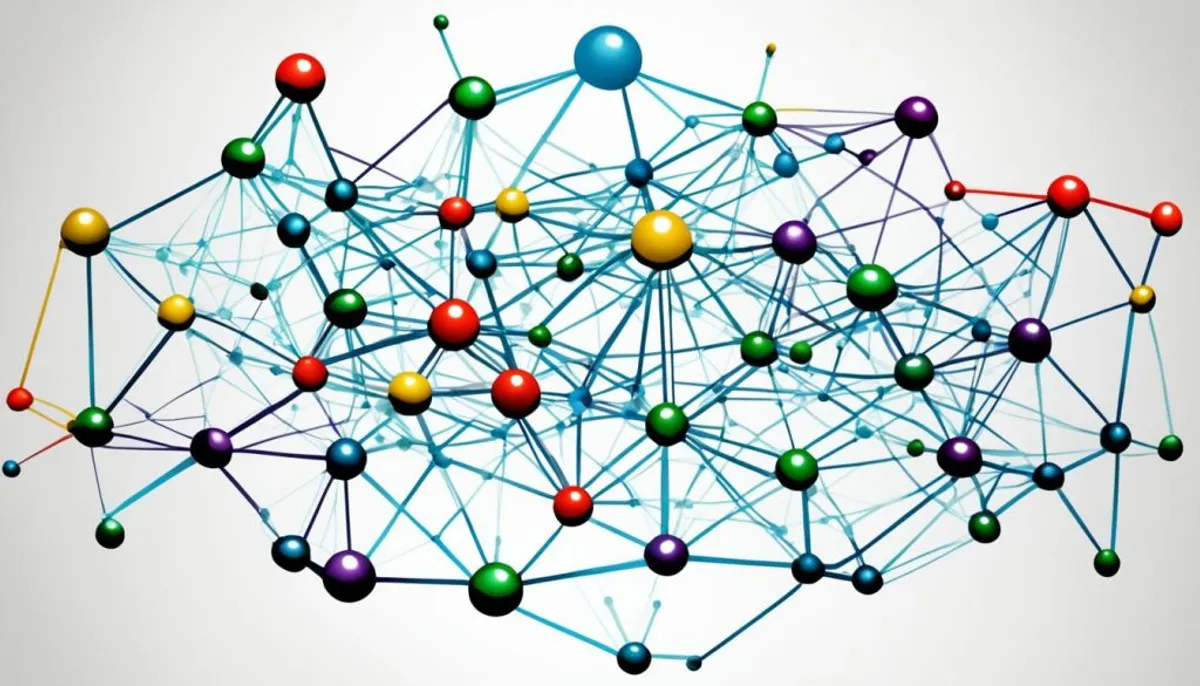Discover the power of social network analysis with the Social Network Analysis KTU Notes: Study Guide. It’s perfect for students at Kerala Technological University (KTU) taking the Social Network Analysis course. It covers important concepts, techniques, and uses in this exciting field.
Learn the basics of social network analysis. You’ll get into network theory, graph analysis, and data mining. Find out about community detection, influence analysis, link prediction, and recommender systems. These skills are key in today’s social media analytics world.

Start your journey into ontologies and knowledge representation. Learn how to do ontology engineering and development. Get to know the latest semantic web applications and services, like semantic search, web services, and even a personalized microsite.
Stay ahead with the latest emerging trends and research in social network analysis. This study guide will prepare you to use social network analysis effectively. You’ll get insights that can give you an edge in your studies and career.
Introduction to Social Network Analysis
Social Network Analysis (SNA) is a field that looks into the complex web of social ties and interactions. It uses insights from graph theory, sociology, anthropology, and computer science. This helps us see the patterns and dynamics in social networks. By studying how people, groups, or organizations connect, SNA offers valuable insights for many areas like social media, marketing, health, and managing organizations. Additionally, a php social network platform can enhance the development and analysis of these social ties.
What is Social Network Analysis?
Social network analysis is all about studying social networks. These are the connections and interactions that make up our social world. It uses network theory and graph analysis to spot community detection, understand influence analysis, and predict link prediction in these networks.
With SNA, experts can see how information, ideas, and behaviors move through networks. They can spot key players and how groups change over time. This info helps in many areas, from better marketing to improving health programs.
Social network analysis gives us deep insights, including aspects of vanity fair nature. It helps people and organizations make better choices and find hidden patterns. As we spend more time online, knowing how to use social networks becomes even more crucial.
Ontologies and Knowledge Representation
Ontologies and knowledge representation are key in the Semantic Web. They aim to make the World Wide Web better by adding metadata that computers can read. This makes it easier for computers to understand and use information.
Important languages for the Semantic Web are Resource Description Framework (RDF), RDF Schema (RDFS), and the Web Ontology Language (OWL). These languages help make ontologies. Ontologies are structured ways to share knowledge, and interprofessional collaboration is essential in defining classes, properties, and relationships, making it easier to share data across different areas.
- RDF is a basic standard for the Semantic Web. It uses subject-predicate-object expressions, or triples, to share information about resources.
- RDFS adds more to RDF. It lets you describe properties and classes of RDF resources, making simple ontologies.
- OWL is more advanced. It uses RDF and RDFS to create complex ontologies with deeper meanings and reasoning abilities.
These languages, along with XML and the Semantic Web vision, have changed how we share and process knowledge. They help across many applications and areas, including the benefits of social media regulation.

| Ontology Language | Key Features | Applications |
|---|---|---|
| RDF | Fundamental Semantic Web standard for representing information in the form of triples | Data integration, information exchange, knowledge representation |
| RDFS | Extends RDF by providing a vocabulary for describing properties and classes of RDF resources | Simple ontology creation, data modeling, schema definition |
| OWL | More expressive language that builds upon RDF and RDFS, offering advanced constructs for defining complex ontologies | Sophisticated knowledge representation, reasoning, and inference |
Ontology Engineering and Development
Ontology engineering is about making and managing ontologies. It’s key for the Semantic Web, where we can share and use knowledge across different areas. This process helps make knowledge work together better.
Ontology Construction and Tools
Creating an ontology involves steps like analyzing the domain, thinking about concepts, making them formal, putting them into action, and checking how well they work. Tools like Protégé, OntoEdit, and SWOOP help with this process.
These tools support languages like OWL and help with checking, reasoning, and combining ontologies. With ontology tools, developers can make, change, and see ontologies more easily. This makes ontology engineering and ontology development for the Semantic Web more effective. Additionally, leveraging live streaming can enhance the way developers interact with these tools, providing real-time feedback and collaboration.
| Ontology Tool | Key Features |
|---|---|
| Protégé | Open-source ontology editor and framework for building intelligent systems |
| OntoEdit | Supports ontology engineering tasks such as editing, browsing, and versioning |
| SWOOP | Web-based ontology editor and browser for the Semantic Web |
Social Network Analysis KTU Notes
The Social Network Analysis KTU Notes are a great study guide for KTU students. They cover the basics of network analysis, graph theory, and social media analytics. Maintaining strong family ties is also essential in understanding social dynamics. Students get a deep understanding of the subject.
These notes touch on many topics, including:
- Network theory and social network structure
- Graph analysis to find important nodes and network features
- Community detection to find hidden groups
- Influence analysis to study how information spreads
- Real-world uses of social network analysis like in recommender systems
The Social Network Analysis KTU Notes offer detailed explanations, examples, and exercises. They help students learn how to use network analysis and data mining in real situations. These notes are a key resource for deepening knowledge in social network analysis, vocabulary building, and its uses in social media analytics.
| Key Concepts | Covered in KTU Notes |
|---|---|
| Network analysis | ✓ |
| Graph theory | ✓ |
| Community detection | ✓ |
| Influence analysis | ✓ |
| Social media analytics | ✓ |

Semantic Web Applications and Services
The Semantic Web is a new layer on top of the World Wide Web. It uses machine-readable metadata and formal ontologies, including coppa compliance, to make it easier for machines to understand and share information. Semantic Web applications and services use these new tools to solve problems in many areas.
Semantic Search and Web Services
Semantic search uses ontologies and knowledge representations to make search results better. It goes beyond just looking for keywords. Also, OWL-S (Web Ontology Language for Services) helps create semantic web services. These services can be found, put together, and run by software agents easily.
These Semantic Web-powered applications and services make sharing knowledge, combining data, and making smart decisions easier.
| Feature | Benefit |
|---|---|
| Semantic Search | Improved relevance and accuracy of search results by leveraging ontologies and knowledge representations |
| Semantic Web Services | Easier discovery, composition, and execution of web services using OWL-S |
| Knowledge Management | Enhanced data integration and intelligent decision-making through Semantic Web-powered applications |
Emerging Trends and Research
The field of social network analysis and the Semantic Web is always changing. New trends and research directions keep coming up. Local networking experts are finding new ways to mix social network analysis with semantic technologies. This aims to bring deeper insights and better network modeling and analysis.
Researchers are now focusing on using machine learning and data mining to get valuable insights from big social network data. As the Semantic Web and social network analysis come together, they’re looking at new ways to use these tools in fields like public health, urban planning, and business intelligence.
Another big trend is using ontologies for better network modeling and analysis. Ontologies help structure knowledge, making it easier to understand social relationships and information flows in complex networks. This mix of social network analysis, semantic web, and knowledge representation opens up new chances for ontology engineering and making decisions based on data. Furthermore, the importance of healthcare teamwork in these networks cannot be overstated, as it enhances collaboration and improves outcomes.
Researchers are also looking into the ethical sides of using social network analysis. They’re focusing on privacy, data security, and avoiding bias in algorithms. As social networks grow in power, it’s important to tackle these future trends and research directions. This ensures that using social network analysis and the Semantic Web is done right and helps people and society.
| Emerging Trend | Description |
|---|---|
| Integration of Social Network Analysis and Semantic Web | Leveraging the combination of social network analysis and semantic technologies for more advanced network modeling and analysis |
| Machine Learning and Data Mining in Social Network Analysis | Applying data-driven techniques to extract valuable insights from the growing volume and complexity of social network data |
| Ontology-driven Social Network Analysis | Utilizing ontologies to enhance the understanding of social relationships, information flows, and community structures within social networks |
| Ethical Considerations in Social Network Analysis | Addressing privacy, data security, and algorithmic bias concerns in the application of social network analysis |
The Semantic Web and social network analysis are coming together, offering exciting chances for new applications and better decision making. Researchers and experts are leading the way in using these technologies to understand human social interactions better, including enhancing tiktok engagement.
Conclusion
The Social Network Analysis KTU Notes: Study Guide has explored how social network analysis meets the Semantic Web. It covered the basics, methods, and uses of this field. This guide has given students the tools to use social network analysis for better insights and new solutions.
It touched on key topics like ontologies and how to represent knowledge. It also showed how to apply these ideas in real-world settings. This guide is a strong tool for understanding the latest in this fast-changing area, including whatsapp communication trends. It will help students, researchers, and professionals keep up with new trends.
Studying social network analysis, semantic web, knowledge representation, ontology, data analytics, research, and social media apps for adults is more important than ever. The world needs data-driven insights and new solutions for big challenges. The Social Network Analysis KTU Notes: Study Guide lays a strong base for those wanting to make a mark in this exciting field.
RelatedRelated articles



